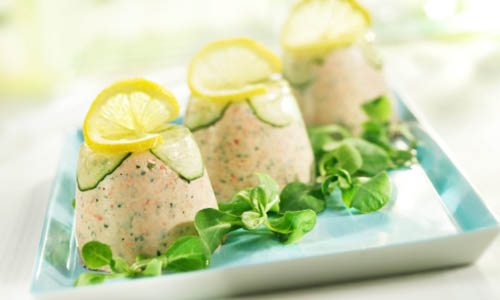
Ingredients for 4 servings:
- 120 g cucumber
- 150 g smoked salmon
- 2 tbsp mascarpone (Italian fresh cheese)
- 250 g low-fat yoghurt
- ½ tsp medium-strength mustard
- 1 tsp honey
- 6 sheets of gelatine or 1 sachet (9 g) of powdered gelatine (for 500 ml of liquid)
- Salt, pepper
- A few dashes of lemon juice
In addition:
- Lemon and lamb’s lettuce as a garnish
Preparation:
- First, soak the gelatine in cold water.
- Wash the cucumber and cut 12 very thin slices for the moulds. Then finely chop the rest of the cucumber. Finely dice the salmon and purée it with the mascarpone and diced cucumber. Add the yoghurt, mustard and honey and mix until smooth. Season with salt, pepper and lemon juice.
- Squeeze out the excess moisture from the gelatine and heat gently to dissolve. Stir 1 tablespoon of the mousse into the gelatine and then fold the gelatine mixture into the rest of the mousse.
- Rinse 4 moulds (capacity approx. 200 ml) with cold water and place 3 cucumber slices in each. Spoon the salmon mousse into the moulds, smooth the surface and refrigerate for roughly 2 hours.
- Turn out onto a plate, garnish with a lemon slice and serve with lamb’s lettuce.
Click here for more information on cooking and baking with gelatine.
Nutritional values per serving approx.:
- Calories: 125
- Joules: 522
- Protein: 12.0 g
- Fat: 6.5 g
- Carbohydrates: 4.5 g
Salmon – the all-rounder in the kitchen
In the past, salmon was an expensive, rare delicacy reserved for wealthy connoisseurs; today, it is a great favourite among all consumers. One look at the fine, pink meat is enough to make your mouth water, and as this delicious fish is available in the shops in a variety of forms, there are lots of different ways to prepare it.
But it is not just its taste that makes salmon a little all-rounder. Its polyunsaturated fatty acids in particular play an important role in protecting the cardiovascular system. These omega-3 fatty acids – which are found in few other foods – help to regulate cholesterol levels and have a positive effect on blood clotting. Salmon also contains vitamins A and D and is a good source of vitamin B12 and iodine. With its high – but healthy – fat content, salmon does contain more calories than many white fish, but is fine to eat at least once a week.
The salmon served in Europe tends to be farm-raised fish from Ireland or Norway. It is still fairly rare to find wild varieties on the menu. However, this is no longer such a big issue – the taste and quality of farm-raised salmon has improved significantly, enabling it to cast off its bad reputation. The meat is firm and aromatic, and checks are regularly carried out to detect any traces of antibiotics.
Alongside fresh and frozen salmon, smoked fish is also a common product in supermarkets. This can be incorporated into a range of different dishes very quickly and easily. Once the packet has been opened, it is important to use the salmon quickly and not to store it for too long. Smoked salmon is generally cold smoked. The salty taste comes from the thick layer of pure sea salt which is rubbed into it before it is smoked over beechwood or birch wood. This contributes to the aromatic flavour of smoked salmon, giving this and other recipes a very distinctive quality.
Bon Appétit!